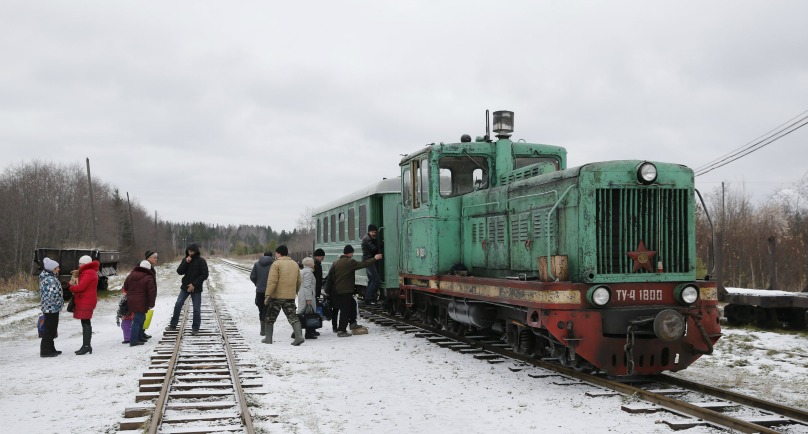Image: People wait to board a train in the village of Ugolnaya, in Sverdlovsk region, Russia, October 16, 2015. REUTERS/Maxim Zmeyev
By Maxim Zmeyev
KALACH, Russia (Reuters) – In a remote corner of the Russian Urals region of Sverdlovsk, tiny villages are shadows of their former selves. For the few local residents, a narrow-gauge railway is their lifeline.
The tracks end at Kalach, home to just a dozen people, all of them adults.
The forestry industry here suffered when the former Soviet Union imploded and people moved away in search of work in the steelmaking city of Yekaterinburg and beyond.
About 600 people lived in Kalach about 30 years ago.
“Those were the days,” said Alexander, who used to work in the forestry business.
He recalls the trains that used to take timber from the forests to the railhead in the town of Alapayevsk.
Boarding a 50-year-old diesel train on this line is like going back in time.
The trains run a few times a week, so some in Kalach use a Pioneer motorized railcar to get around. They are nicknamed “Trouble” because they often crash or come off the tracks.
An estimated 90 percent of Sverdlovsk region’s population of 4.5 million live in its cities. Life in remote rural areas means making the best of things.
In Kalach there are no telephones and no mobile reception. Electricity has only been supplied for a few hours in the evening for about the past decade.
Still, that has improved the quality of life for Sergei, 62.
“It used to get pretty boring,” says Sergei, who cares for his mother, 86, the village’s oldest resident. “I’d be going to bed at 8pm, tossing and turning.”
Most of the residents of Kalach, the youngest of whom is aged 34, are self-sufficient. Bread arrives by train. The cows have now gone, replaced by sheep.
“We grow our own food,” adds Sergei, speaking in a room with traditional religious icons hanging on the wall. “Potatoes, tomatoes, cucumbers. What else do we need?”
All of a sudden he jumps up, leaves the room and brings back an accordion, playing a tune his father taught him. That kind of spontaneous hospitality was typical of the people I met along the railway.
In Strokinka, home to about 20 residents, I met train driver Alexander Kuznetsov. For him the Russian railways, which employ almost a million people, are a family affair, as his father and grandfather were also railwaymen.
The isolation of these communities makes healthcare a difficulty. One resident gave birth to her son Yegor, now 6, in the train on the way to hospital in Alapayevsk.
It takes about eight hours to travel the full 150 km (100 miles) of the line. En route is the town of Sankin, population 600, where Kalach residents get their post delivered and, for some, collect their state pensions once a month. Clothes sellers arrive in town that day.
While in Sankin, snow starts to fall and I see a disused railway carriage in the middle of town. A knock on the window comes from a nearby building. In the town’s cultural center sit four middle-aged women: Elena, Olga, Tatyana and Galina.
They invite me to join them but every time I pick up my camera they hide away the vodka shot glasses in their hands. Before long we are swapping stories and toasting each other in the Russian tradition.
Singing soon follows and Galina treats us to a rendition of a song called: “Dark Forest, Dark Forest”.
(Writing by Brian McGee; Editing by Angus MacSwan)
Copyright 2015 Thomson Reuters. Click for Restrictions.


